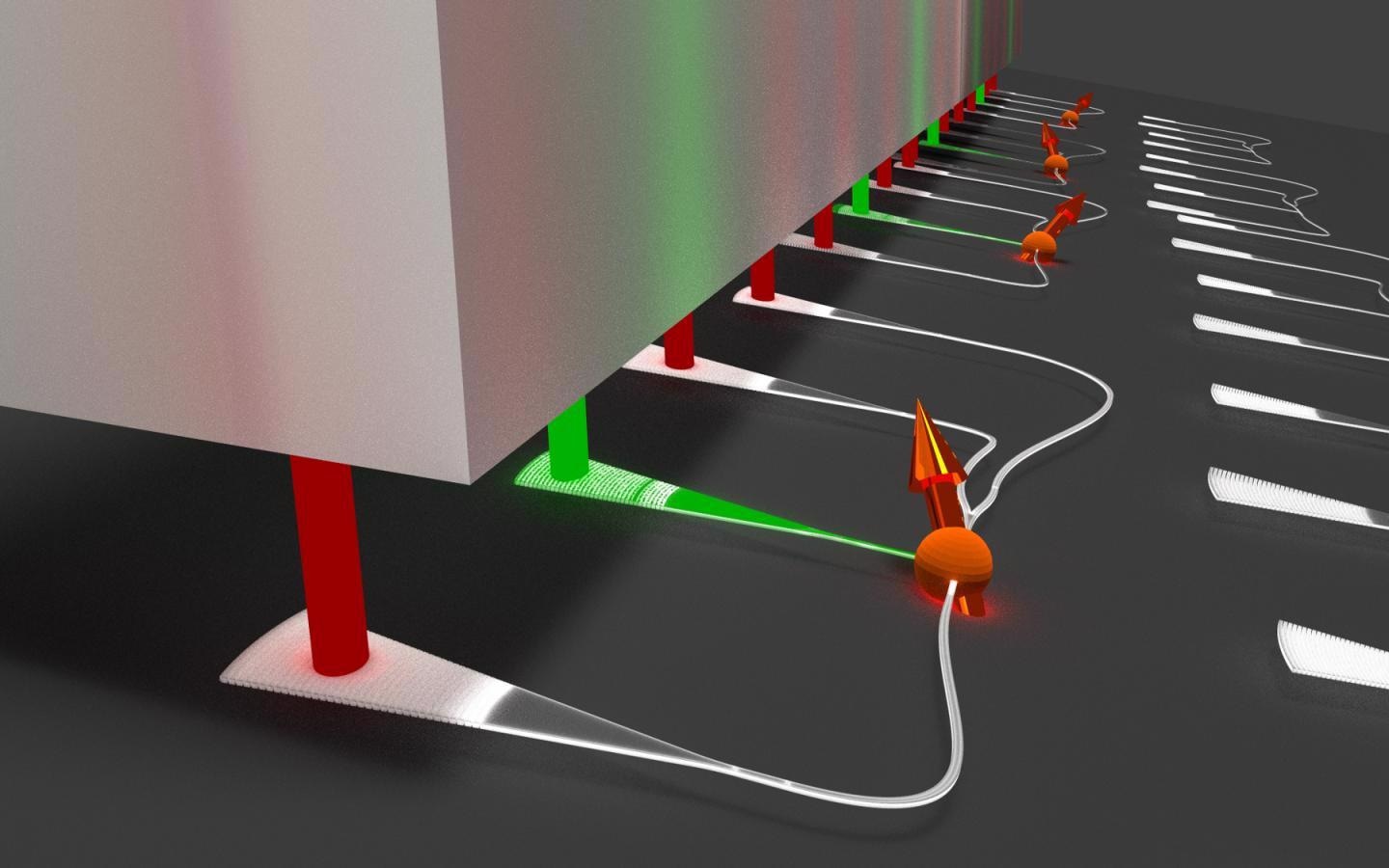Nov 24 2020
Structures measuring only a few nanometers in size could now be produced using advanced nanotechnology.
 Nanophotonic integration for simultaneously controlling a large number of quantum mechanical spins in nanodiamonds. Image Credit: P. Schrinner/AG Schuck
Nanophotonic integration for simultaneously controlling a large number of quantum mechanical spins in nanodiamonds. Image Credit: P. Schrinner/AG Schuck
This realm of the smallest particles, also referred to as quantum systems, offers an array of technological applications in many different fields, like information processing, magnetic field sensing, ultra-precise timekeeping, or secure communication.
The development of such microscopically tiny structures has advanced so much that their dimensions measure less than the wavelength of light. In this manner, it is now feasible to break down the hitherto existent limitations encountered in optics and apply the quantum characteristics of light. To put this in simple terms, nanophotonics represents an innovative technique to quantum technologies.
As each photon shifts in the quantum regime, investigators describe the pertinent sources of light as quantum emitters. These quantum emitters can be integrated into nanodiamonds, among others. Unique diamonds like these are defined by their microscopically small particle size, which can span from only a few to several hundred nanometers.
Now, for the first time, scientists from the University of Münster were able to fully incorporate the nanodiamonds into nanophotonic circuits and simultaneously addressed a number of these nanodiamonds optically.
During this process, green laser light is focused on the color centers in the nanodiamonds, and all the individual red photons that are produced within the nanodiamonds are discharged into a grid of nanoscale optical components. Consequently, the team can currently regulate these quantum systems in a fully incorporated state. The study results have been published in the Nano Letters journal.
Background and Methodology
Earlier, bulky microscopes had to be set up to regulate such quantum systems. With the help of fabrication technologies, just like the ones used for creating chips for computer processors, light can be guided in a similar manner using waveguides, or nanofibers, on a single silicon chip.
Such optical waveguides, which measure less than a micrometer, were created using the reactive ion etching equipment and electron-beam lithography at the Münster Nanofabrication Facility (MNF).
Here, the size of a typical experimental set-up was shrunk to a few hundred square micrometres. This downsizing not only means that we can save space with a view to future applications involving quantum systems in large numbers, but it also enables us, for the first time, to control several such quantum systems simultaneously.
Carsten Schuck, Assistant Professor, Institute of Physics, University of Münster
Schuck headed the study in association with Doris Reiter, an Assistant Professor from the Institute of Solid State Theory.
In the initial research work, which was performed before the present study, the researchers from the University of Münster designed appropriate interfaces between the nanophotonic circuits and nanodiamonds. Such interfaces were utilized in the latest experiments, in which waveguides were used to couple the quantum emitters in a particularly effective manner.
The physicists used the so-called Purcell effect in their experiments. This effect causes the nanodiamond to discharge the individual photons with a higher possibility into the waveguide, rather than in some haphazard direction.
The team was also able to run a couple of magnetic field sensors, which were built on the incorporated nanodiamonds, in parallel on a single chip. Earlier, this could be achieved only successively or individually.
To make this method feasible, the team subjected the incorporated nanodiamonds to microwaves, and thus induced variations in the quantum (spin) state of the color centers. The spin orientation affects the brightness of the nanodiamonds, which was later read out with the help of the on-chip optical access.
The frequency of the microwave field and the visible changes in the brightness rely on the magnetic field at the site of the nanodiamond.
The high sensitivity to a local magnetic field makes it possible to construct sensors with which individual bacteria and even individual atoms can be detected.
Philip Schrinner, Study Lead Author, University of Münster
Using extensive 3D simulations, the researchers initially computed the nanophotonic interface designs and thereby established optimal geometries. They subsequently assembled and created these parts into a nanophotonic circuit.
After integrating and characterizing the nanodiamonds through adapted technology, the physicists performed the quantum mechanical measurements by using a set-up adapted for the purpose.
Working with diamond-based quantum systems in nanophotonic circuits allows a new kind of accessibility, as we are no longer restricted by microscope set-ups. Using the method we have presented, it will be possible in the future to simultaneously monitor and read out a large number of these quantum systems on one chip.
Doris Reiter, Assistant Professor, Institute of Solid State Theory, University of Münster
The investigators’ study paves the way for performing more studies in the area of quantum optics—research works in which nanophotonics can be used to alter the photophysical characteristics of the diamond emitters.
Besides this, novel application possibilities exist in the field of quantum technologies, which will gain from the characteristics of integrated nanodiamonds—for instance, in the field of quantum information processing or quantum sensing.
The next steps of the researchers will involve applying quantum sensors in the field of magnetometry, as used, for instance, in materials analysis for brain scans or semiconductor components.
“To this end, we want to integrate a large number of sensors on one chip which can then all be read out simultaneously, and thus not only register the magnetic field at one place, but also visualize magnetic field gradients in space,” concluded Schuck.
Funding
The Ministry of Culture and Science of the State of North Rhine-Westphalia has funded the study.
Journal Reference:
Schrinner, P. P. J., et al. (2020) Integration of Diamond-Based Quantum Emitters with Nanophotonic Circuits. Nano Letters. doi.org/10.1021/acs.nanolett.0c03262.
Source: https://www.uni-muenster.de/